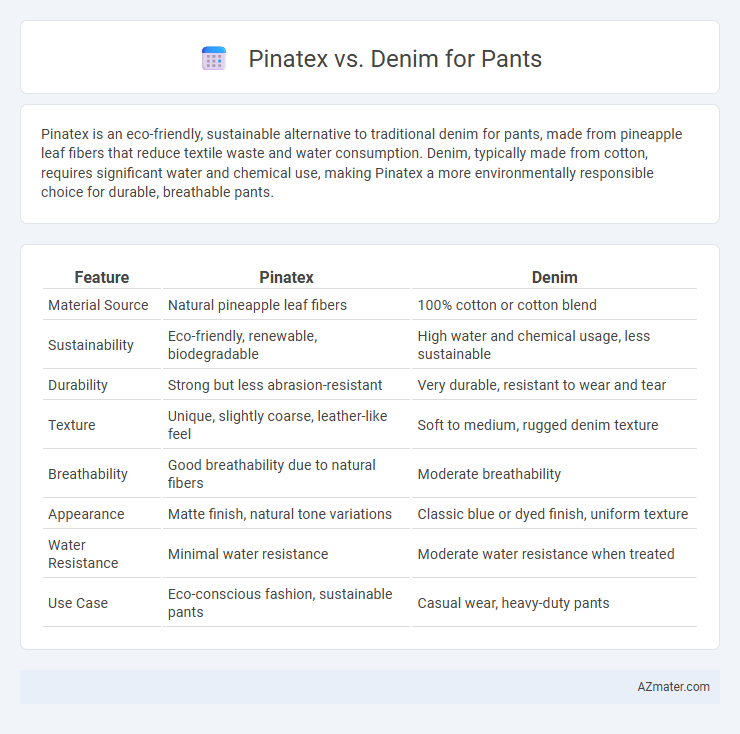Pinatex is an eco-friendly, sustainable alternative to traditional denim for pants, made from pineapple leaf fibers that reduce textile waste and water consumption. Denim, typically made from cotton, requires significant water and chemical use, making Pinatex a more environmentally responsible choice for durable, breathable pants.
Table of Comparison
| Feature | Pinatex | Denim |
|---|---|---|
| Material Source | Natural pineapple leaf fibers | 100% cotton or cotton blend |
| Sustainability | Eco-friendly, renewable, biodegradable | High water and chemical usage, less sustainable |
| Durability | Strong but less abrasion-resistant | Very durable, resistant to wear and tear |
| Texture | Unique, slightly coarse, leather-like feel | Soft to medium, rugged denim texture |
| Breathability | Good breathability due to natural fibers | Moderate breathability |
| Appearance | Matte finish, natural tone variations | Classic blue or dyed finish, uniform texture |
| Water Resistance | Minimal water resistance | Moderate water resistance when treated |
| Use Case | Eco-conscious fashion, sustainable pants | Casual wear, heavy-duty pants |
Introduction to Piñatex and Denim
Pinatex is an innovative sustainable fabric made from pineapple leaf fibers, offering an eco-friendly alternative to traditional textiles. Denim, primarily composed of cotton, is a classic durable fabric well-known for its strength and comfort in pant manufacturing. Both materials present unique qualities, with Pinatex emphasizing environmental benefits and Denim focusing on long-lasting wearability and versatility.
Material Origins and Sustainability
Pinatex is a sustainable alternative to denim, made from pineapple leaf fibers, which are a byproduct of the pineapple harvest, reducing agricultural waste and water consumption significantly compared to cotton-based denim. Denim primarily relies on cotton, a resource-intensive crop requiring vast amounts of water and pesticides, contributing to environmental degradation. Pinatex's natural fibers offer biodegradability and lower carbon emissions, positioning it as an eco-friendly material for pants with a reduced environmental footprint.
Production Process Comparison
Pinatex, derived from pineapple leaf fibers, undergoes a sustainable production process that minimizes water usage and eliminates harmful chemicals compared to traditional denim, which relies heavily on cotton cultivation requiring vast water resources and pesticides. The manufacturing of Pinatex involves natural fiber extraction and eco-friendly treatments, while denim production often includes energy-intensive dyeing and washing steps, contributing to higher environmental impact. Choosing Pinatex over denim reduces pollution and conserves resources during the pant production lifecycle, aligning with sustainable fashion goals.
Environmental Impact Analysis
Pinatex, made from pineapple leaf fibers, offers a sustainable alternative to denim by utilizing agricultural waste and reducing water consumption by up to 90% compared to traditional cotton denim production. Denim manufacturing requires substantial amounts of water, pesticides, and energy, contributing heavily to pollution and greenhouse gas emissions. Pinatex's biodegradable properties and lower carbon footprint make it a more environmentally friendly choice for pants, supporting circular economy principles and reducing textile waste.
Durability and Longevity
Pinatex offers impressive durability with its pineapple leaf fibers, providing a sustainable alternative that resists wear and tear while remaining lightweight and flexible. Denim, made from tightly woven cotton, is renowned for its exceptional toughness, long-lasting comfort, and ability to withstand frequent washing and heavy use. Both materials ensure longevity, but denim typically maintains structural integrity longer under intense physical activities, whereas Pinatex excels in eco-friendly resilience and breathability.
Comfort and Wearability
Pinatex offers a lightweight, breathable alternative to traditional denim, making it ideal for warm weather and extended wear due to its natural pineapple leaf fibers. Denim, known for its durability and stretch variants, provides a structured fit but can feel heavier and less breathable, potentially causing discomfort in hot climates. Both materials offer distinct wearability profiles, with Pinatex excelling in moisture-wicking and flexibility, while denim remains favored for rugged, everyday use.
Style and Aesthetics
Pinatex offers a unique, eco-friendly alternative to denim with its natural, textured surface made from pineapple leaf fibers, providing a distinctive, matte finish that appeals to sustainable fashion enthusiasts. Denim retains its classic, rugged aesthetic with a versatile range of washes and finishes, embodying timeless style and durability. Both materials allow for creative expression in pants design, but Pinatex stands out for its innovative, plant-based origin and contemporary fashion appeal.
Cost and Market Availability
Pinatex, a sustainable alternative made from pineapple leaf fibers, generally costs more than traditional denim due to its eco-friendly production process and limited large-scale manufacturing. Denim remains widely available and cost-effective, benefiting from established supply chains and mass production, making it more accessible in the global market. Market availability of Pinatex pants is still niche, primarily in eco-conscious and premium segments, whereas denim dominates mainstream fashion worldwide.
Care and Maintenance Requirements
Pinatex pants require gentle washing with cold water and air drying to preserve the natural pineapple fibers and prevent weakening or deformation. Denim pants demand regular washing but can withstand higher temperatures and more vigorous laundering without significant damage, although over-washing may lead to fading and loss of shape. Both materials benefit from avoiding harsh chemicals and drying in direct sunlight to extend their lifespan.
Final Verdict: Which Is Better for Pants?
Pinatex offers a sustainable and cruelty-free alternative to traditional textiles, made from pineapple leaf fibers that provide breathability and durability, ideal for eco-conscious fashion. Denim remains a classic choice known for its robustness, versatility, and wide availability, but its conventional production often involves high water usage and chemical treatments. For pants, Pinatex is better suited for those prioritizing environmental impact and ethical sourcing, while denim excels in durability and style familiarity.

Infographic: Piñatex vs Denim for Pant
 azmater.com
azmater.com